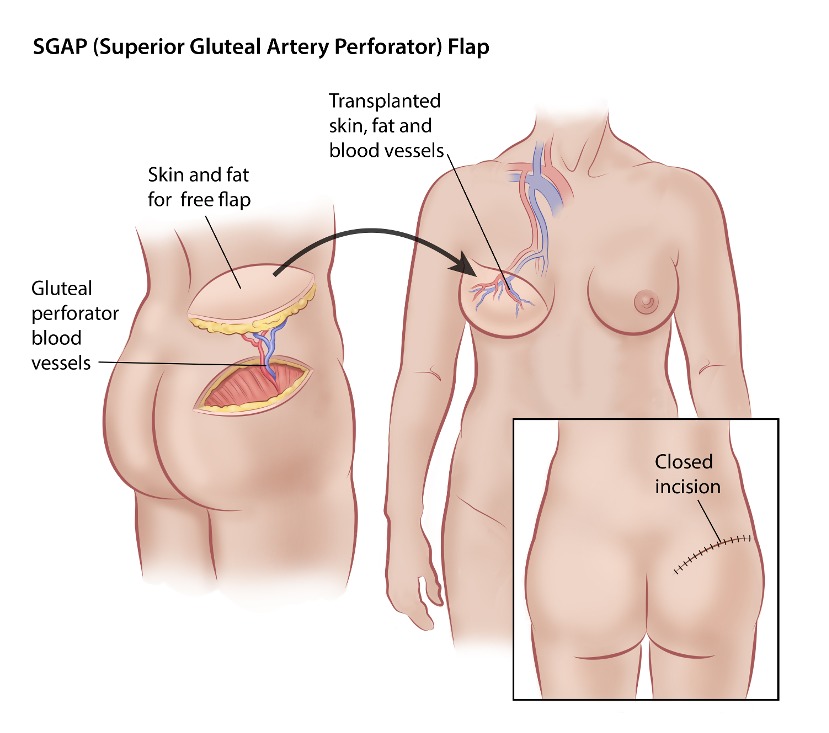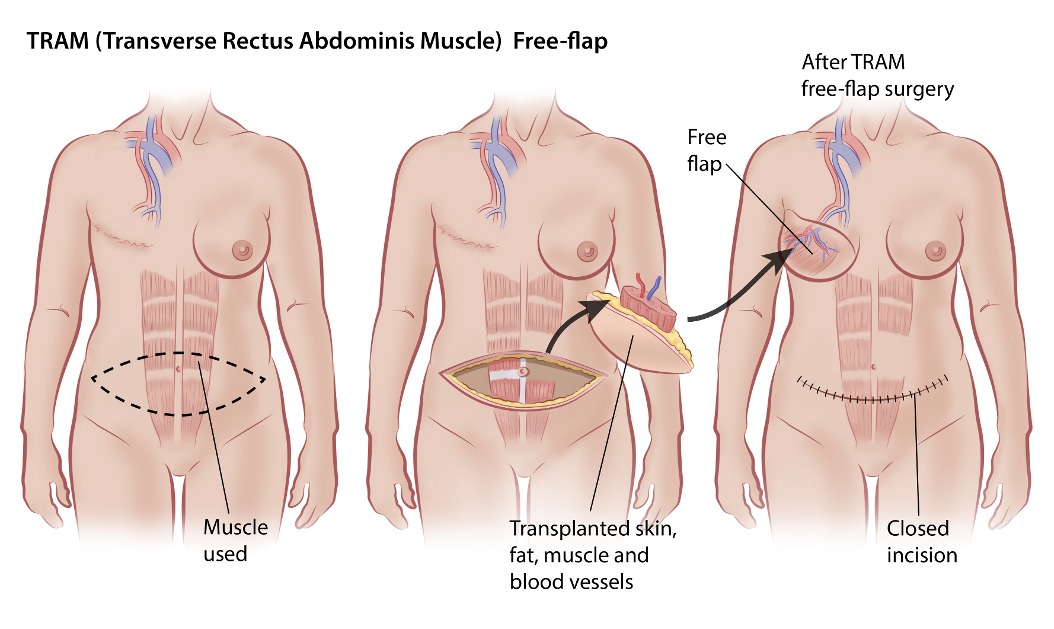By continuing to use our site, you consent to the processing of cookies, user data (location information, type and version of the OS, the type and version of the browser, the type of device and the resolution of its screen, the source of where the user came from, from which site or for what advertisement, language OS and Browser, which pages are opened and to which buttons the user presses, ip-address) for the purpose of site functioning, retargeting and statistical surveys and reviews. If you do not want your data to be processed, please leave the site.
The Voice of People With Breast Cancer
helping you understand your surgical options
SurgeryGuide
Jump to:
Autologous Reconstruction
This type of reconstruction uses your tissue which results in softer, more natural feeling breast than if implants were used. Because the reconstructed breast(s) is made up of living tissue and no additional material is used in the reconstruction, future surgeries to maintain the breast(s) aren’t necessary. You may require additional surgeries to adjust the size or shape of the reconstructed breasts, if you desire. It’s important to note that because living tissue from another part of your body is used you will have an additional scar at the donor site, a lot of the sites are in areas that are often covered up by clothing.
Types of Autologous Reconstruction
-
DIEP Flap (Deep Inferior Perforator Flap)
 “I had DIEP reconstruction, that did not involve moving any of my abdominal muscles but did include a tummy tuck and the manufacture of a new tummy button. I also had to have a follow up surgery to reduce the size of my "normal" breast and give it a "perk me up", which I believe is all done in one surgery now. For me it meant another trip to Winnipeg. After all was healed, I had another trip to make a nipple and then another one to tattoo color around it. My challenges were mostly the trips in and out and the mental issues, ie: once you start on the journey you need to complete it and sometimes you wonder why you started.
“I had DIEP reconstruction, that did not involve moving any of my abdominal muscles but did include a tummy tuck and the manufacture of a new tummy button. I also had to have a follow up surgery to reduce the size of my "normal" breast and give it a "perk me up", which I believe is all done in one surgery now. For me it meant another trip to Winnipeg. After all was healed, I had another trip to make a nipple and then another one to tattoo color around it. My challenges were mostly the trips in and out and the mental issues, ie: once you start on the journey you need to complete it and sometimes you wonder why you started.I am generally pleased with the result. It is not identical to my normal breast but then I am the one who knows this. In my bra/swim suit or clothes no one else could tell. I do like being rid of the prostheses.
I had no complications at all and was treated with respect by all the health care providers.”
~Sheila~- Excess fat and skin from below the belly button is moved to the breast
- Doesn’t use any muscle, only fat, to rebuild the breast
- Can require muscle cutting to identify blood vessel supplying the tissue, and move those to the chest
- Core strength is preserved
- Quicker recovery time because there is no muscle moved
- Surgeons must have expertise in microsurgery
- Not usually an option for women without extra belly fat
- Not usually an option if you’ve previously had certain abdominal surgeries
- Not a good surgery if you are very thin or very overweight, the surgeons typically see more complications with very thin or very overweight women
- Most frequently performed autologous reconstruction because the belly is the best donor site
Click here to see before and after photos of real women.
-
SGAP (Superior Gluteal Artery Perforator)
- Skin and fat tissue from upper hip region is transplanted to chest
- Doesn’t use any muscle, so the muscle of the upper hip is protected and preserved
- Doesn’t take fat from lower buttock or upper thigh, which prevents long-term discomfort while sitting and eliminates the risk of tissue breakdown
- Surgeons must have expertise in microsurgery
- Incision is small
- Scar is left at the top of your buttocks and is usually covered by underwear or a swimsuit
- Good option if using tissue from the abdomen isn’t an option
Click here to see before and after photos of real women.
-
IGAP (Inferior Gluteal Artery Perforator)
 “I was young and felt reconstruction was right for me. I would change my choice now, I had an IGAP flap and I think the recovery would have been easier with an implant. Recovery would have been easier, knowing what I know now. Having one surgical site to recover from would have been faster and easier on my body. With the surgery site being an IGAP flap, it meant not being able to sit for almost 4 weeks. It made day-to-day tasks complicated, things, like sitting on the toilet or sitting at the dinner table, were impossible.
“I was young and felt reconstruction was right for me. I would change my choice now, I had an IGAP flap and I think the recovery would have been easier with an implant. Recovery would have been easier, knowing what I know now. Having one surgical site to recover from would have been faster and easier on my body. With the surgery site being an IGAP flap, it meant not being able to sit for almost 4 weeks. It made day-to-day tasks complicated, things, like sitting on the toilet or sitting at the dinner table, were impossible. There were a few appointments after surgery that were required, as I was to have chemotherapy. Getting in a car was a challenge. As well, getting up and onto the scanning machines was also hard. Most technicians had not seen the surgery I had and it was imperative my husband help me onto the tables. I would not trust anyone else at that time.
As well, I had a 10 and 12-year-old at home. I laid in bed for 4 weeks and had limited mobility. They were used to seeing me up and at the gym. I could not do much around the house and that made it more apparent that I was sick. It certainly took a toll on my family. I feel going straight to an implant would have been a speedier recovery, with less scarring on my body.”
~Tara~- Skin and fat tissue from the lower hip region is removed from the lower buttock
- Less ideal than SGAP because this area is where you bear weight when sitting which can make it uncomfortable to sit, especially during recovery
- Doesn’t use the muscle
- Scar is left in the butt crease which generally isn’t seen
- May leave your buttocks smaller and tighter but some of the natural shape may be lost
- Not performed as frequently because of more complications with the donor site
Click here to see before and after photos of real women.
-
TRAM flap (transverse rectus abdominis)
- Uses muscle, fat and skin tissue from your lower abdomen
- Because this uses muscle the recovery time is longer and there may be a loss of core strength
- Less muscle is usually used in the free TRAM flap procedure than the pedicle TRAM flap procedure
- Not a good choice if you don’t have extra belly tissue or if you’ve already had many abdominal surgeries
Click here to see before and after photos of real women.
 “I had a TRAM reconstruction after right sided mastectomy. I developed seromas in my abdominal site that had to be drained every month for six months. After three months they tried putting in a new drain but it got infected almost right away and I was on antibiotics for two weeks. Then three months later they admitted me to hospital and opened up the abdominal donor site and apparently the abdomen was "a mess" as the mesh that the doctor used to strengthen my abdominal wall had not integrated into the surrounding tissue and actually broke down into fragments that all had to be removed during a long surgery.
“I had a TRAM reconstruction after right sided mastectomy. I developed seromas in my abdominal site that had to be drained every month for six months. After three months they tried putting in a new drain but it got infected almost right away and I was on antibiotics for two weeks. Then three months later they admitted me to hospital and opened up the abdominal donor site and apparently the abdomen was "a mess" as the mesh that the doctor used to strengthen my abdominal wall had not integrated into the surrounding tissue and actually broke down into fragments that all had to be removed during a long surgery. Once that issue was cleared up and my abdomen healed all was well. My left breast, which was lifted and reduced, healed very well and looks fantastic. The reconstructed breast also healed well and both breasts match and look like the "real" thing. I did have a nipple constructed using the origami technique. This lost its profile after a year. I then got the plastic surgeon to inject it with restylane. This lasted a couple of years but then it also flattened out and I was at the point after a few years where I didn't really want to have anymore interventions and ceased to care about having "one headlight" as my husband says. I found a nipple cover at a lingerie store which does the trick when I have on thin tops.
I would say that beside the side effects of the mesh in my abdomen, the other most disconcerting issue was loss of sensation in my entire trunk. It's very difficult emotionally waking up to the reality of having your entire torso, which used to be sensitive to the touch, to be completely numb. I only had sensation in one breast and then my right breast and entire torso down to my pubic area felt dead to me. That sounds harsh but it took me quite awhile to not be saddened by that loss of sensation. It definitely has an impact on your sex life. When you run your own hand over your tummy and not really have a sense of where your hand is if you're not looking...that was hard. It has taken years to regain sensation in that area despite being told it might only be five years. It's now 12 years since my surgery and I can feel most of my torso except for a 4" circumference around my umbilicus. And of course no sensation in my reconstructed breast, which some women have said they regained. Not me.
I was very happy to wake up from surgery with two breasts that matched, were reduced and lifted after losing some of that youthfulness, and I had a tight and flat tummy. Despite not being over-weight, I still had a post baby tummy so it was very cool to wear tight jeans and tight tees again after all these years. If I could promise a woman that she wouldn't have the issues with seromas that I had, I would highly recommend immediate reconstruction after a mastectomy. I actually felt quite sexy despite losing the sensation in that one breast, just in terms of my outside appearance. I also loved having my own tissue in my new breast...it really feels just like a "real" breast with breast tissue. It moves like the other one and if I lose weight so does my chest, and if I gain weight so do my breasts. They look very natural.
I think it's really important, especially if you love the touch of your hand or your lovers touch to know that there is an entire erogenous zone from your neck to your pubic area that is numb for many years to come. I think there are more advanced surgeries for woman who need a mastectomy and want reconstruction that don't result in the cutting of so many nerves in your abdomen. I would seek out those practitioners who are doing that kind of surgery. I loved using my own tissue as opposed to having a foreign body inside me, but I think the loss of sensation to your torso is a big price to pay for many years.”
~Colleen~ -
Latissimus Dorsi Flap
- Kim
-
 “After speaking with my plastic surgeon about the various options that were available to me, I made an informed decision to get the latissimus dorsi flap reconstruction done. I had already gone through radiation which caused changes in the elasticity of my skin and also had a history of infection from my lumpectomy one year prior. By doing the latissimus dorsi flap, it would help minimize the risk of infection and allow for more skin elasticity and a more desired outcome by using healthy tissue from my back.
“After speaking with my plastic surgeon about the various options that were available to me, I made an informed decision to get the latissimus dorsi flap reconstruction done. I had already gone through radiation which caused changes in the elasticity of my skin and also had a history of infection from my lumpectomy one year prior. By doing the latissimus dorsi flap, it would help minimize the risk of infection and allow for more skin elasticity and a more desired outcome by using healthy tissue from my back. I was grateful to have a surgeon who explained the process in great detail but also spent a lot of time on the internet doing my own research so I knew what to expect. I also spoke to other women who had been through it and could provide valuable insight as to their own first-hand experience with this type of reconstruction. I think it's important to have as many resources as possible and helps make things a little less scary when you know what to expect. One thing I did not expect though was the significant loss of feeling in my back where the skin and tissue was removed. Although some of the feeling has returned, there will always be a loss of sensation which is troubling sometimes.
Was I pleased overall with the results? Yes and no. While my right affected (cancer) breast looked and felt more natural than expected, my non-affected side was the problem child. I had gaps and indents along my breast and a loose pocket of skin underneath that didn't get filled out from the expansions. I have come to learn though that breast reconstruction is never a perfect process and it can take time (and a lot of patience) to get the results to where you want them to be.
I think it's really important for others to be prepared going into a surgery like this. The healing time is significant and it is hard to go about your daily activities for at least a couple of weeks. Having a good support system lined up is key to helping do things like making dinner, walking the dog, taking kids to school and cleaning around the house. I had meals prepped beforehand and items on hand that would help keep me comfortable during recovery like a drain dolly to hold the multiple drains in one place, a pillow to stick under each arm for bed or while resting on the couch, and a seatbelt pillow for the car.”
~Kim~
- Susan
-
 “One thing that might be good for others to know is the back may feel very numb for a very long time ... I always describe it like feeling like a piece of wood - it can take a couple of years for all the feeling to return to the area. If there is any feeling in the area it should all return eventually. This surgery sounds very daunting but I found it pretty easy to recover from and have no restriction in movement due to this surgery.
“One thing that might be good for others to know is the back may feel very numb for a very long time ... I always describe it like feeling like a piece of wood - it can take a couple of years for all the feeling to return to the area. If there is any feeling in the area it should all return eventually. This surgery sounds very daunting but I found it pretty easy to recover from and have no restriction in movement due to this surgery.Another thing to be aware of is a small possibility of capsular contracture happening with any permanent implant - this just happened to me and I had surgery to exchange the implant in January. Breast reconstruction can be as easy as one surgery but it can mean several surgeries over time; however everyone I know is happy they had it done, including me. I have met many, many women who either wish they had had reconstruction or wish they had been offered reconstruction, it just makes you feel normal again.
Every woman should at the very least be given all of her treatment options at the time of her diagnosis. I had the best possible care and given every option and my mission is to help all women who have not been as fortunate as I have been. I have been extremely pleased with the results.
~Susan~
- Cheryl
-
 “Its been just over a year since I had the implants put in and honestly I don't like the feeling of them. They feel like a foreign object that now is a part of me. On the side where they removed the cancer, it causes me the most problems while moving certain ways. I was going to go back to the surgeon and let him know, however a bone scan that was done last month showed Costochandral inflammation in the chest and rib on the right side, this is due to previous rib fractures.
“Its been just over a year since I had the implants put in and honestly I don't like the feeling of them. They feel like a foreign object that now is a part of me. On the side where they removed the cancer, it causes me the most problems while moving certain ways. I was going to go back to the surgeon and let him know, however a bone scan that was done last month showed Costochandral inflammation in the chest and rib on the right side, this is due to previous rib fractures. After my double mastectomy the plastic surgeon put in my expanders in the same surgery. Every 3 weeks I went to the plastic surgeon and he would give me my CC's of fluid to fill the expanders. The surgery was June 23 and by Nov, I had my last one and then I ended up in emergency in horrible pain a few days later. Apparently the last amount of fluid was too much for me and it was resting on my diaphragm. A few days later the surgeon drained me on the one side and it gave me instant relief.
We then went to plan B which was the flap surgery where they took about 9 inches in the width of my back and brought that skin and tissue to the front. My back has never been the same since. They look good but there is so much numbness in both the front and the back of me. I was warned it would be like this. The flap surgery affects a lot of the nerves and I’m left with what feels like to me a block of wood in my back. Like something that doesn't belong there. My range of motion has been affected too. I think that is the scar tissue.
I’m pleased with the look of the implants and I now have a perfect size C. I don’t have to wear a bra, so some good things did come out of this.
I would want others to know that you have to expect to have weird feelings with the implants as they do feel odd, like something is just sitting there on your chest. And that it wasn't until I had the nipple tattoos, that I finally felt I looked whole again and 1/2 normal. I’m still very shy around my husband. I still hide from him. I feel abnormal. I guess it’s the scars, the implants and the fake nipples make me feel not real anymore. Yet on the other hand, in the mirror I look okay.”
~Cheryl~
- Corinne
-
 “I had the Dorsi Flap procedure done, muscle was taken from the back and moved to the front. Expanders were put in and for six months, every second week I would have saline injections to stretch the skin. The biggest challenge was the recovery time after the initial surgery. It was a hard surgery that I wasn’t properly made aware of. Surgery was harder than anticipated and recovery time was longer than expected. I would recommend the full year wait after the mastectomy to ensure you are ready, mentally and physically.
“I had the Dorsi Flap procedure done, muscle was taken from the back and moved to the front. Expanders were put in and for six months, every second week I would have saline injections to stretch the skin. The biggest challenge was the recovery time after the initial surgery. It was a hard surgery that I wasn’t properly made aware of. Surgery was harder than anticipated and recovery time was longer than expected. I would recommend the full year wait after the mastectomy to ensure you are ready, mentally and physically. I was encouraged to go earlier as the hospital had some cancellations before the Christmas season; which was a bad idea. I was not well enough to enjoy Christmas that year and recovery time was way underestimated by the surgeon. I found the first few fills very painful but got much more tolerable as time went on and also had smaller fills.
I was pleased with the results, the surgeon did a great job. I waited a couple of years and am now ready for the final procedures, tattoo and nipple reconstruction. Was physically tired of surgeries after the expanders were removed and the inserts put in. It was a hard surgery and I’m glad now that it is over. Sometimes I felt the surgery was harder than the cancer treatments.
My advice would be to do your research and get best option for your body type. Have a couple pieces of clothing with inside pockets (many sports tops/hoodies have them); they were a life savers to carry around the drains in the incisions”
~Corinne~
- Uses the latissimus dorsi muscle located in your upper back
- Muscle and fat from this area are used
- Flap is moved under your skin so it continues to be attached to the original blood supply in your back
- Significant amount of muscle is used
- May be a good choice for women who aren’t good candidates for DIEP, SIEA or TRAM flaps
- Option for small or medium sized breast reconstruction
- Muscle loss in the back may make it harder to lift things and twist
- Often times an implant is also needed with this type of flap
- Because the muscle is harder and tighter the reconstructed breast might feel harder and tighter
Click here to see before and after photos of real women.
-
PAP Free Flap (Profunda Artery Perforator Flap)
- Uses skin and fat from the upper inner and back of the thigh
- No muscle is taken from the donor site
- May be an option for women who aren’t good candidates for DIEP or other abdomen-based flaps
- Surgeons must have expertise in microsurgery
- Option for smaller or medium sized breast reconstruction
Click here to see before and after photos of real women.
-
LAP Free Flap (Lumbar Artery Perforator Flap)
- Uses skin and fat from the lower back and upper buttock (the “love handles”)
- No muscle is taken from the donor site
- Shaping of this flap is easier compared to any other flaps due to the quality of the fat in this area
- May be an option for women who aren’t good candidates for DIEP or other abdomen-based flaps
- Surgeons must have expertise in microsurgery
Click here to see before and after photos of real women.
-
SIEA Flap (Superficial Inferior Epigastric Artery)
- Uses fat from the lower abdomen
- Different from DIEP flap because a different section of blood vessels are moved with the flap
- The DIEP flap requires a small incision in the layer of tissue that covers the abdominal muscles, whereas the SIEA flap doesn’t require this
- The strongest blood flow, either to the SIEA flap vessels or the DIEP flap vessels will usually determine which type of these surgeries is best for you
- Doesn’t use any muscle
- No loss of core strength
Click here to see before and after photos of real women.

